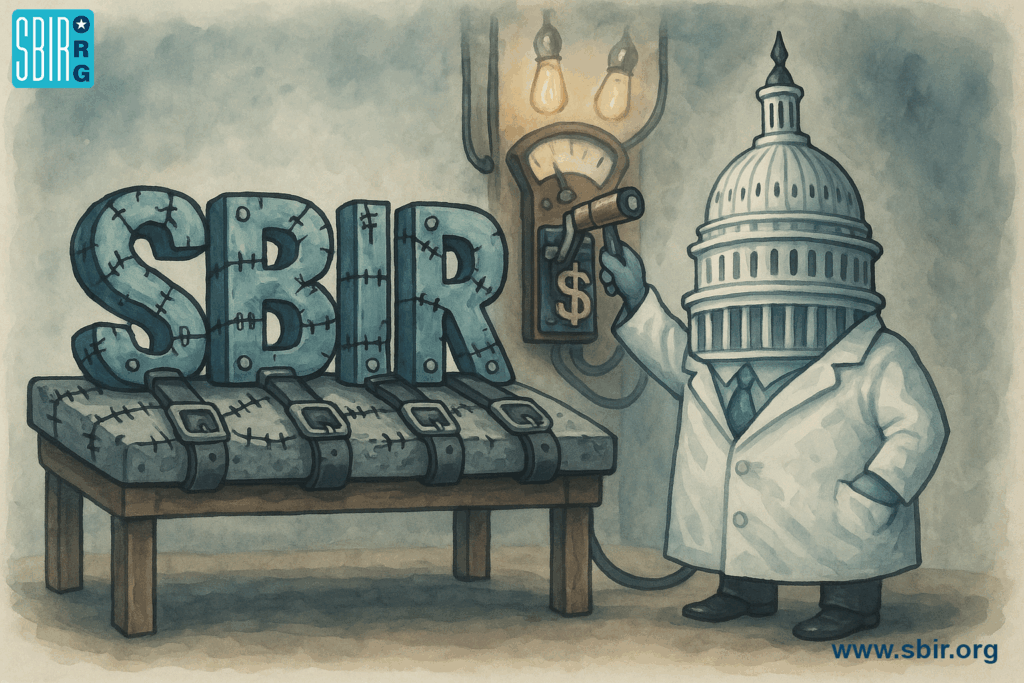SBIR Reauthorization Status as of November

After more than 40 years of fueling innovation, the Small Business Innovation Research (SBIR) and Small Business Technology Transfer (STTR) programs hit a roadblock at the end of FY2025. The SBIR/STTR authority expired on September 30, 2025, as Congress failed to pass a reauthorization in time(**). Lawmakers had floated various fixes – from short-term extensions to making the program permanent – but none were enacted by the deadline. This lapse meant that, effective October 1, agencies lost the legal authority to issue new SBIR/STTR awards or solicitations, although existing funded projects could continue for now(**). The timing coincided with the longest federal government shutdown in US history, which further complicated matters by furloughing agency staff and pausing most contracting activities.
With the program in limbo, federal agencies like DoD, DOE, and NSF were forced to halt new SBIR/STTR funding rounds. Ongoing SBIR contracts remained valid, but no new grants or contracts could be awarded until Congress acts. The Pentagon issued guidance that current SBIR contracts “remain valid unless otherwise directed,” but new solicitations are paused and pending awards will proceed only if prior-year funds are available. In short, “agencies are unable to issue new SBIR/STTR…awards until Congress provides clear reauthorization”. Small tech firms that rely on these awards now face mounting uncertainty. As one Air Force magazine noted, the $4.2 billion SBIR program effectively went into “hibernation” on Oct. 1 – and unless lawmakers strike a deal on reforms, the program could come to an abrupt end instead of restarting(**).
Path Forward: NDAA as the Likely Vehicle for Reauthorization
Given the deadlock on a stand-alone bill, lawmakers are eyeing the upcoming National Defense Authorization Act (NDAA) for FY2026 as the rescue vehicle for SBIR. The NDAA is a “must-pass” annual defense policy bill – precisely the kind of larger package that often carries smaller authorizations or fixes that Congress couldn’t pass on their own. According to Politico, Sen. Ernst has said “her way” of moving the SBIR/STTR renewal forward will be to attach it to the NDAA(**). (Ernst introduced her comprehensive SBIR reform bill – the INNOVATE Act – back in March, and folding its provisions or a compromise version into the NDAA would achieve her goal of reform with reauthorization(**).) In fact, Ernst signaled as early as summer that she might seek to tuck SBIR reauthorization language into the defense bill, anticipating the difficulty of passing it alone.
So far, both the House and Senate have passed their initial versions of the NDAA, and SBIR did come up during that process. Each chamber’s NDAA contained some SBIR-related provisions (likely reflecting pieces of Ernst’s reform agenda and other tweaks). However, neither bill yet addresses the core issue of extending the program’s statutory sunset. As of mid-October, the Covington government contracts team noted that “the legislative vehicles most likely to move in the near term – the NDAA and a continuing resolution – offer no relief” on SBIR, since the versions at that point didn’t include an extension of authority. This indicates that the plan is to add the SBIR reauthorization into the final NDAA during conference negotiations between the House and Senate (rather than having been in the original drafts). Those NDAA conference talks are happening in November 2025, aiming to finalize the bill by year’s end. Congressional staff will have to agree on SBIR language that can ride on the NDAA and satisfy both Ernst and SBIR supporters.
So when will SBIR be reauthorized? The expectation among many in Washington is that a deal will be struck before the end of 2025. Historically, Congress has often pushed SBIR renewals to the 11th hour (for example, a similar lapse was narrowly avoided in late 2022 by a last-minute compromise that extended SBIR for three years). This time, the program did lapse, but pressure is mounting to resolve it in the next legislative vehicle. Attaching SBIR to the NDAA is seen as the most viable path, as it “may represent the most pragmatic legislative path forward, as it could bypass the gridlock that often stalls standalone bills.” If all goes well, the FY2026 NDAA – likely to pass in December 2025 – would carry a section reauthorizing SBIR/STTR. This could either be a short-term extension (e.g. one-year, giving time for further talks) or a longer-term reauthorization with agreed-upon reforms. Notably, there is also a House-passed continuing resolution (CR) in play to fund the government; while the last CR lacked SBIR provisions, any year-end omnibus appropriations deal could theoretically include an SBIR fix as well, if NDAA were to falter.
As of November 12, 2025, however, no final agreement has been announced. Senate and House negotiators are keeping details close while hammering out the compromise. The stakes are high – more than $4 billion in annual small business R&D funding is on hold. Lawmakers from both parties insist they don’t want to kill the program; even Sen. Ernst emphasizes she wants SBIR to continue, just with reforms. That suggests a deal is likely, even if it means each side giving some ground (perhaps a temporary cap or stricter reporting requirements instead of a permanent award cap, etc.).
Bottom Line: Barring unforeseen setbacks, the SBIR/STTR programs are expected to be reauthorized by late 2025, most likely as part of the must-pass NDAA. This would restore agencies’ ability to solicit and fund new awards, “swiftly resuming” the program’s functions. If Congress misses that window and fails to include SBIR in the NDAA or an appropriations package, the lapse would drag on into 2026 – an outcome that policymakers and industry alike are striving to avoid given the damage it would cause to America’s innovation pipeline. For now, small businesses and research agencies must sit tight, but all signs point to a resolution on the horizon. As a House–Senate joint statement put it, “both chambers continue to work toward reforms and long-term reauthorization” – so the focus is on getting a stopgap extension in place to “ensure America’s small businesses can continue advancing breakthroughs” while the finer points of reform are settled.
